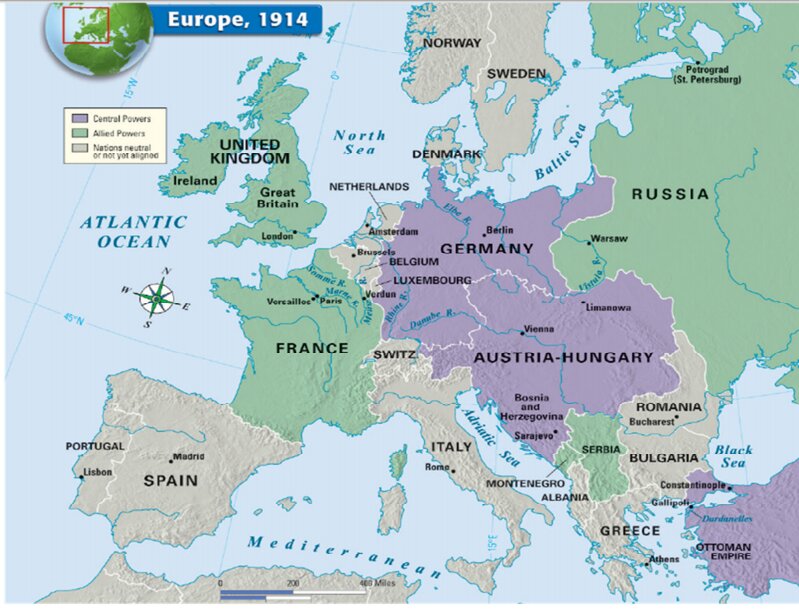Views: 1,234
Table of Contents
World War I
- World War I (WW I), also known as the Great War, lasted from 28 July 1914 to 11 November 1918.
- WW I was fought between the Allied Powers and the Central Powers.
- The main members of the Allied Powers were France, Russia, and Britain. The United States also fought on the side of the Allies after 1917.
- The main members of the Central Powers were Germany, Austria-Hungary, the Ottoman Empire, and Bulgaria.
Causes of the War
There was no single event that led to World War I. The war happened because of several different events that took place in the years building up to 1914.
- The new international expansionist policy of Germany: In 1890 the new emperor of Germany, Wilhelm II, began an international policy that sought to turn his country into a world power. Germany was seen as a threat by the other powers and destabilized the international situation.
- Mutual Defense Alliances: Countries throughout Europe made mutual defence agreements. These treaties meant that if one country was attacked, allied countries were bound to defend them.
- The Triple Alliance-1882 linking Germany with Austria-Hungary and Italy.
- The Triple Entente, which was made up of Britain, France, and Russia, concluded by 1907.
- Thus, there were two rival groups in Europe.
Fig: Alliances at the beginning of the War
- Imperialism: Before World War I, Africa and parts of Asia were points of contention among the European countries because of their raw materials. The increasing competition and desire for greater empires led to an increase in the confrontation that helped push the world into World War I.
- Militarism: As the world entered the 20th century, an arms race had begun. By 1914, Germany had the greatest increase in military buildup. Great Britain and Germany both greatly increased their navies in this time period. This increase in militarism helped push the countries involved into war.
- Nationalism: Much of the origin of the war was based on the desire of the Slavic peoples in Bosnia and Herzegovina to no longer be part of Austria Hungary but instead be part of Serbia. In this way, nationalism led to the War.
- Assassination of Archduke Franz Ferdinand: In June 1914, Archduke Franz Ferdinand, the heir to the throne of Austria-Hungary, was shot while he was visiting Sarajevo in Bosnia. He was killed by a Serbian person, who thought that Serbia should control Bosnia instead of Austria. Because its leader had been shot, Austria-Hungary declared war on Serbia. As a result:
- Russia got involved as it had an alliance with Serbia.
- Germany then declared war on Russia because Germany had an alliance with Austria-Hungary.
- Britain declared war on Germany because of its invasion of neutral Belgium – Britain had agreements to protect both Belgium and France.
- Some of the major battles during the war included the First Battle of the Marne, Battle of the Somme, Battle of Tannenberg, Battle of Gallipoli, and the Battle of Verdun.
Phases of the War
- The conflict developed on several fronts in Europe, Africa, and Asia. The two main scenarios were the Western front, where the Germans confronted Britain, France and, after 1917, the Americans. The second front was the Eastern front in which the Russians fought against Germans and Austro-Hungarians.
- After a brief German advance in 1914, the western front was stabilized and a long and brutal trench warfare started: it was a “war of attrition” (the western front remained immovable). Meanwhile on the Eastern Front the Germans advanced but not decisively.
- In 1917, two events changed the course of the war: the United States joined the Allies and Russia, after the Russian revolution, abandoned the conflict and signed a separate peace.
- Finally after the German offensive in the spring of 1918, the Allied counterattack managed to force a decisive retreat of the German army. The defeat of its Germany’s allies and the revolution in Germany that dethroned Wilhem II (German Emperor), brought about the signing of the armistice on November 11, 1918. The Great War was over.
Consequences of the war
- Economic consequences: World War I cost the participating countries a lot of money. Germany and Great Britain spent about 60% of the money their economy produced. Countries had to raise taxes and borrow money from their citizens. They also printed money in order to buy weapons and other things they needed for war. This led to inflation after the war.
- Political Consequences: World War I brought an end to four monarchies: Czar Nicholas II of Russia, Kaiser Wilhelm of Germany, Emperor Charles of Austria and the sultan of the Ottoman Empire had to step down.
- New countries were created out of old empires. Austria- Hungary was carved up into a number of independent states.
- Russia and Germany gave land to Poland. Countries in the Middle East were put under the control of Great Britain and France.
- What was left of Ottoman Empire became Turkey.
- Social Consequences: World war changed society completely. Birth rates declined because millions of young men died (eight million died, millions wounded, maimed, widows and orphans). Civilians lost their land and fled to other countries.
- The role of women also changed. They played a major part in replacing men in factories and offices. Many countries gave women more rights after the war had ended, including the right to vote.
- The upper classes lost their leading role in society. Young middle and lower class men and women demanded a say in forming their country after the war.
- Treaty of Versailles: On June 28, 1919, World War I officially ended with the signing of the Treaty of Versailles. The Treaty of Versailles was an attempt to prevent the world from going into another war.
Treaty of Versailles
It is organized in several chapters each having different clauses.
Territorial clauses:
- France regained Alsace and Lorraine
- Eupen and Malmedy passed into the hands of Belgium
- Eastern territories were annexed by Poland which caused East Prussia to become territorially isolated.
- Danzig and Memel, former Baltic German cities were declared free cities
- Denmark annexed northern Schleswig-Holstein
- Germany lost all of its colonies and the victors annexed them
Military clauses:
- Drastic limitation of the German navy.
- Dramatic reduction of the Army (only 100,000 troops, prohibition of having tanks, aircraft and heavy artillery).
- Demilitarization of the Rhineland region.
War Reparations:
- The treaty declared Germany and its allies responsible for all ‘loss and damage’ suffered by the Allies and as a consequence they were forced to pay war reparations to the victors.
Other Treaties
The Treaty of Neuilly, signed with Bulgaria
- The small Balkan country suffered several territorial losses, in the benefit of Romania, Greece and a brand-new country: Yugoslavia.
The Treaty of Sevres (1920) signed with Turkey
- The Treaty of Sevres was extremely hard and led to the Turkish national rebellion, which was led by Kemal Ataturk. This also led to the war against Greece, which occupied large areas of Anatolia.
However, the war also brought other important social and ideological changes
- The U.S., which had won the war but had not experienced the conflict on its territory, became a first world power.
- The mass mobilization of men led to the incorporation of women into the workforce, which was a major step forward for women’s rights.
- The triumph of the Soviet Revolution (Russian Revolution) and the social crisis that followed the war encouraged workers in many countries to protest, creating a pre-revolutionary climate.
- The extreme nationalism experienced during the war, coupled with fear of a Communist revolution, encouraged the middle-class populations of some countries to move to the extreme right. This created a hotbed of fascist movements.
- Creation of the League of Nations: The League of Nations was an international diplomatic group developed after World War I as a way to solve disputes between countries before they erupted into open warfare. A precursor to the United Nations, the League achieved some victories but had a mixed record of success.
India and WWI
- India being a former British colony played a vital role in helping Britain and its allies win over Germany and allies, a role that is often overlooked.
- Being a British colony, the Indian Army contributed a large number of soldiers to the European, Mediterranean and the Middle East conflicts of war in World War I.
- The Indian Army fought against the German Empire in East Africa and also on the Western Front.
- They served in places as diverse as France and Belgium, Mesopotamia, Egypt, Gallipoli, Palestine and Sinai.
- More than 70 thousand of the Indian soldiers who served British in World War I lost their lives. Sir Claude Auchinleck, Commander-in-Chief of the Indian Army once said: ” Britain couldn’t have come through the wars if they hadn’t had the Indian Army.”
- As high as 100 million British Pounds was given by India to Britain to fund their war anticipating dominion status and home rule in return.
- The British raised men and money from India, as well as large supplies of food, cash, and ammunition, collected by British taxation policies. In return, the British promised to award self-rule to India at the end of the war which eventually was not delivered.
However, the “war to end all wars” turned out to be the opposite. By ensuring Germany’s economic ruin and political humiliation through the Treaty of Versatile, the post-war settlement provided fertile ground for World War II.




